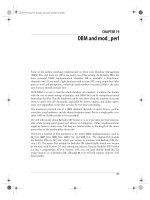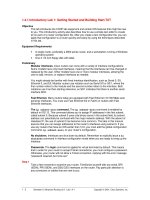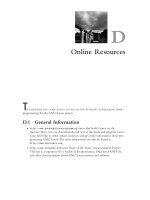Practical mod_perl-CHAPTER 23:Getting Help and Online Resources
Bạn đang xem bản rút gọn của tài liệu. Xem và tải ngay bản đầy đủ của tài liệu tại đây (129.47 KB, 11 trang )
This is the Title of the Book, eMatter Edition
Copyright © 2004 O’Reilly & Associates, Inc. All rights reserved.
672
Chapter 23
CHAPTER 23
Getting Help and Online Resources
In this chapter, we propose a way to solve your mod_perl-related problems and pro-
vide starting points for information resources related to mod_perl.
If you have any problem with mod_perl itself, be it a build problem or a runtime
problem, you should follow the steps below. But before you follow them, thinkcare-
fully about whether the problem you are experiencing is mod_perl-related. It’s quite
possible that the problem is in the Perl code, SQL code, Apache itself, or something
else entirely. In such cases, you should refer to other resources presented later in this
chapter. Remember that although mod_perl resources might help you with many
related things, they will never be as detailed as resources devoted to the topic at
hand.
If you still thinkthat the problem has something to do with mod_perl, these are the
steps to follow:
1. Try to tackle the problem by yourself for a while. Check that you have the right
permissions, that there is enough diskspace, etc. Do sanity checks: try to remove
the mod_perl source tree, unpack it again, and build from fresh.
When trying to figure out what the problem is, always run under single-server
mode (httpd -X) and always check the error_log file.
If you still have problems, proceed to step 2.
2. Reread the documentation (or if you didn’t read it yet, do it now). Try to follow
the build and usage steps as explained there. This book, Writing Apache Mod-
ules with Perl and C (O’Reilly), and the documentation distributed with the
mod_perl sources provide in-depth details on this topic. Also, make sure to read
Chapter 22 thoroughly. If you are still in trouble, proceed to step 3.
3. Go to the mod_perl list archives (at and see
whether someone has already reported the same problem. If someone did,
chances are that a cure to the problem has been posted to the list, be it a source
,ch23.25760 Page 672 Thursday, November 18, 2004 12:46 PM
This is the Title of the Book, eMatter Edition
Copyright © 2004 O’Reilly & Associates, Inc. All rights reserved.
How to Report Problems
|
673
patch or a workaround. If after doing an exhaustive search you haven’t come up
with any solution, proceed to step 4.
Notice that sometimes doing this step before step 2 can be a good idea as well—
you may happen to have encountered a well-known bug, and if that’s the case
doing a quick lookup in the mailing-list archives will save you time and frustration.
4. This step is the last resort. Contact the mod_perl mailing list. You should never
abuse this step, and use it only when you have already been through the previ-
ous three steps. If you askFAQ questions unnecessarily, chances are that people
will not reply to you. And if you askmore FAQ questions, you might get onto
people’s blacklists and they will not answer your future questions even if they
are relevant. Remember that all the answers that you get are coming from volun-
teers who, instead of having fun outdoors, try to have fun answering challenging
questions. FAQ questions aren’t challenging, and few people have fun answer-
ing them. See more details about mod_perl list etiquette in the next section.
It’s not enough to just contact the list and askfor help. You have to provide as
many details as possible. The next section covers the details you have to provide.
However, don’t be afraid. The mod_perl mailing list is filled with only nice peo-
ple who can provide much help and guidance, so if you can’t figure something
out after having followed the above steps, your question is welcome.
You cannot post to the list without first subscribing to it. To subscribe, send an
email to After you receive a confirmation
email, you can start posting to the list. Send your emails to modperl@perl.
apache.org.
There are other related mailing lists you might want to be on too. See the list of
these and subscription instructions in the Resources section of this chapter.
How to Report Problems
When reporting a problem to the mod_perl mailing list, always send these details:
• Anything in the error_log file that looks suspicious and possibly related to the
problem
• Output of perl -V
• Version of mod_perl
• Version of Apache
• Options given to mod_perl’s Makefile.PL file
• Server configuration details
•Ifmake test fails, the output of make test TEST_VERBOSE=1
,ch23.25760 Page 673 Thursday, November 18, 2004 12:46 PM
This is the Title of the Book, eMatter Edition
Copyright © 2004 O’Reilly & Associates, Inc. All rights reserved.
674
|
Chapter 23: Getting Help and Online Resources
Also check whether:
• make test passes 100%
• The script works under mod_cgi, if applicable
You should try to isolate the problem and send the smallest possible code snippet
that reproduces the problem.
Getting the Backtrace from Core Dumps
If you get a core dump (segmentation fault), send a backtrace if possible. Before you
try to produce it, rebuild mod_perl with:
panic% perl Makefile.PL PERL_DEBUG=1
which will:
• Add -g to
EXTRA_CFLAGS
• Turn on
PERL_TRACE
• Set
PERL_DESTRUCT_LEVEL=2
(additional checks during Perl cleanup)
• Link against libperld, if it exists
You can read a full explanation in Chapter 21, but here is a summary of how to get a
backtrace:
panic% cd mod_perl-1.xx
panic% gdb ../apache_1.3.xx/src/httpd
(gdb) run -X -f `pwd`/t/conf/httpd.conf -d `pwd`/t
[now make request that causes core dump]
(gdb) bt
In English: cd to the mod_perl source directory and start gdb with a path to the httpd
binary, which is located in the Apache source tree. (Of course, replace x with real
version numbers.) Next, start the httpd process from within gdb and issue a request
that causes a core dump. When the code has died with the
SIGSEGV
signal, run bt to
get the backtrace.
Alternatively, you can also attach to an already running process like so:
panic% gdb httpd <process id number>
If the dump is happening in libperl, you have to rebuild Perl with -DDEBUGGING
enabled during the ./Configure stage. A quickway to this is to go to your Perl source
tree and run these commands:
panic% rm *.[oa]
panic% make LIBPERL=libperld.a
panic% cp libperld.a $Config{archlibexp}/CORE
where
$Config{archlibexp}
is:
% perl -V:archlibexp
,ch23.25760 Page 674 Thursday, November 18, 2004 12:46 PM
This is the Title of the Book, eMatter Edition
Copyright © 2004 O’Reilly & Associates, Inc. All rights reserved.
Mailing List Etiquette
|
675
Spinning Processes
The gdb attaching to the live process approach is helpful when debugging a spinning
process. You can also get a Perl stacktrace of a spinning process by installing a
$SIG{USR1}
handler in your code:
use Carp ( );
$SIG{USR1} = \&Carp::confess;
While the process is spinning, send it a
USR1
signal:
panic% kill -USR1 <process id number>
and the Perl stack trace will be printed.
Alternatively, you can use gdb to find which Perl code is causing the spin:
panic% gdb httpd <pid of spinning process>
(gdb) where
(gdb) source mod_perl-x.xx/.gdbinit
(gdb) curinfo
After loading the special macros file (.gdbinit), you can use the curinfo gdb macro to
figure out the file and line number in which the code stuck. Chapter 21 talks in more
detail about tracing techniques.
Finally, send all these details to
Mailing List Etiquette
Like any community, the mod_perl mailing list has its own rules of etiquette that you
would be wise to avoid violating:
• Never contact people in person to aska question unless they have explicitly
given you permission. Even if someone was kind enough to reply to a previous
question, this doesn’t mean he wants to be your go-to person for every subse-
quent problem as well. If you do this, don’t be surprised if your question is
ignored. Just thinkabout how many emails these people receive daily, and you
will understand the reason. Remember that this is a voluntary effort, not a tech-
nical support service.
• If a reply to your question is posted to the list and you want to follow up on it, in
most cases you should keep posting to the list, so the conversation will be saved
in the mailing-list archives and can later be reused by other users who seekhelp
in the archives.
• However, if you receive a private email reply to the question, keep the conversa-
tion private, because the person who has answered you might not have wanted
his answer to be seen in public. You have to respect that and not resend the reply
to the list without this person’s permission.
,ch23.25760 Page 675 Thursday, November 18, 2004 12:46 PM
This is the Title of the Book, eMatter Edition
Copyright © 2004 O’Reilly & Associates, Inc. All rights reserved.
676
|
Chapter 23: Getting Help and Online Resources
• When posting to the list, always use relevant subject lines. Don’t just say “help”
in the subject field of your post. Chances are that these messages will be ignored.
Most of the people are interested in only specific topics, and therefore they will
delete messages with unspecific subject lines without even reading them. To
catch their attention, you should provide a concise, meaningful subject line.
• When replying to a message, please try to quote only relevant parts of the origi-
nal post: don’t overquote and don’t overtrim. Refrain from replying on the top
of the original message, since it makes it hard for other users to understand the
conversation. Please use proper quoting delimiters, so users can easily tell your
reply from the original message.
• If your English is not fluent, do not feel frightened to post. The mod_perl com-
munity includes many people for whom English is not their primary language.
But please run a spell-checker before posting if you know that you tend to make
many mistakes. Sometimes people post questions that are never answered sim-
ply because nobody understands the question.
• Avoid posting off-topic (not mod_perl-related) questions. If you really feel that
you have to, at least let others know that the post is off-topic. The correct way to
do that is to start your post’s subject field with the
[OT]
tag.
• Avoid flaming. At least, don’t flame in public—contact others in person if you
really want to. Flaming people in public may hurt their feelings. They might
leave the list, and all of us will lose an active (or potentially active) contributor.
We try hard to make the mod_perl list a fun place to be.
• Remember that sometimes it might take days or even weeks before your ques-
tion is answered, although during the working week most questions are
answered within a few hours. Occasionally, questions aren’t answered at all. If
this is the case, you might want to post again some time later (at least one week),
maybe with more information.
• Finally, use common sense when posting, and you will be fine. Online conversa-
tions needn’t be any different than real-life ones; be polite and precise and every-
body will be happy. Subscribing to the list and spending some time reading the
posts will give you an idea of how things are done.
Resources
This section includes centralized resources that you should find useful when you
workwith mod_perl and related technologies, such as Apache, Perl, CGI, CVS,
Squid, DBI, SQL, Security, etc.
mod_perl
• mod_perl home page: />• mod_perl documentation: />,ch23.25760 Page 676 Thursday, November 18, 2004 12:46 PM









